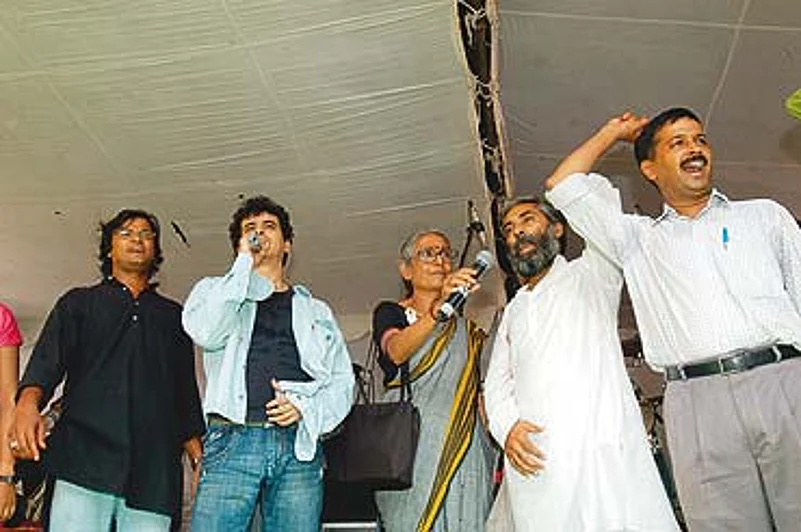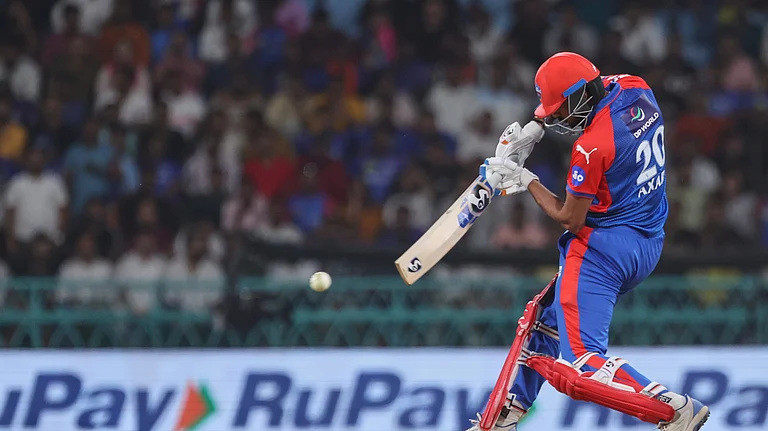"Gandhi was deified, buried in institutions. An irony, given how uneasy he was with institutions." Mushirul Hasan, Historian
"Khadi, charkha are outdated. We now need to climb on Gandhi's shoulders and look ahead."S.K. Dwivedi, Rashtriya Yuva Sangathan
"The youth may not appreciate a dhoti-clad Gandhi. (Till you) say he was a rich barrister who sacrificed all." A. Annamalai, Gandhi Study Circle
***
"The art of living and dying" is how Mohandas Gandhi described his unique tool of resistance, perhaps India's greatest contribution to modern times. But he couldn't find a name for it until he held a contest. The word thrown up was: satyagraha. A hundred years later, a new breed of Gandhians—who have shed the old, faded icon of the Mahatma along with the khadi and the jholas to attract a new, hi-tech generation—is reinventing Gandhian vocabulary by renaming it "9/11". This, in memory of the day when an impassioned young barrister with blazing eyes gathered 3,000 Indians in the Empire Theatre building in Johannesburg on September 11, 1906, and asked them to take an oath to resist their white colonial oppressors without striking a single blow.

| Satyagraha 1913: Gandhi adopts the dress of Tamil indentured labour during his satyagraha in Durban, SA |
Oddly, while the government has yet to wake up to the significance of this event—apart from setting up one of those inevitable committees that has yet to meet—Gandhian youth organisations that have sprung up recently across the country are wresting the initiative away from the usual custodians of the Mahatma in a bid to reach the young. Plans are on to launch their year-long centenary celebrations in fresh, new ways that tie contemporary issues to the reawakened interest in a man who has so far been interred in textbooks and in marigold-engulfed statues. The new-age satyagrahis—a word that they wish to avoid like the politicians in Gandhi topis—will go on peace runs, bicycle yatras for communal harmony, motorbike rallies for Indo-Pak peace and against female foeticide; take Gandhi films and discussion groups to professional colleges, radio programmes and wall newspapers to slums and villages; hold comicbook workshops and roundtable discussions with leaders of all political hues, including advocates of terrorism, "because everyone deserves to be heard".
And it's not just in India. A youthful surge of enthusiasm for Gandhian ideals across the globe is taking aback scholars and teachers who had grown resigned to thinking of him as a "back number". When, for instance, University of Chicago professor and co-author of Postmodern Gandhi, Lloyd Rudolph, started an optional course on Gandhi a few years ago, he expected less than a dozen students to sign up. Instead, over 75 students, a quarter of them of Indian origin, applied. Many had to be turned away. "These are young people mostly from the science or technical streams, agnostic, not driven by dogma or religion, but by norms," Lloyd explains. "They are looking for a course that adds meaning in their life, an answer to that eternal question: what shall I do with my life?" And, suddenly, it's the Mahatma that fits the bill.
Agrees A. Annamalai of Chennai's Gandhi Study Circle, one of the over 150 Gandhian youth organisations in India. "Young people may not be able to relate to a dhoti-clad Gandhi with his charkha," he says. "But tell them how he was a millionaire London-returned barrister (Gandhi's earnings as a barrister were around 5,000 pounds a year in an era when one pound fetched seven grams of gold) who threw away everything to fight for justice and equality, and they begin at once to appreciate him." As a result, says the 40-year-old Gandhian in shirt and trousers who, unlike the old school of Gandhians, laughs a lot: "We've been able to recruit Gandhi enthusiasts from technical and engineering backgrounds, besides software professionals, as volunteers who contribute in many areas such as village industries, eco-friendly products, sensitising policemen and bureaucrats, and helping popularise Gandhi in schools and colleges in ways they can relate to."

Satyagraha 2006: Aruna Roy, Sandeep Dwivedi et al protest dilution of RTI Act
A national survey earlier this month by The Hindu-CNN-IBN bears this out. The survey of Indians below 30 in 19 states showed that nearly 76 per cent rate Gandhi as their top role model. No one is more surprised by this than a generation that has seen Gandhi "enshrined or vandalised", as his grandson and author Gopalkrishna Gandhi puts it. "Gandhi was ill-served by everyone, including the Gandhians," agrees historian Mushirul Hasan. "They deified him and buried him in institutions, which is ironical, considering how uncomfortable Gandhi was with institutions. He was conveniently portrayed as a saint so that they wouldn't be threatened by his ideology."
But the worst disservice done to Gandhi, according to Gopal Gandhi, is how "a vital, witty, disturbing, admonitory, inconvenient, caring, touchstone of a man" was turned into the "one thing he was not: a bore".
Even someone who came to Gandhi through the Marxist route like Aruna Roy is dismayed at how "a very modern, rational, interesting man with a fantastic sense of humour like Gandhi was turned into a fuddy-duddy crashing bore. By turning him into the Father of the Nation, we could ignore him apart from putting up ugly statues at every crossing and garlanding him on October 2". Whereas, Roy points out, "anyone who reads him can't help but engage with him". For activists, Roy says, Gandhi is "irrevocably and absolutely relevant, especially in these three areas: bringing ethical responsibility into public life—no public figure anywhere in the world has examined himself so thoroughly in full public view; bringing a moral position into the economic debate; and his position against communalism, about the equality of all religions".

The maulvi and the mahant at Tulsighat in Benares In these communally-tense times, Gandhi still holds relevance
It is this conviction about Gandhi's potential to engage a new generation that's driving attempts to repackage Bapu as their man for the 21st century. "We have to reach out to the young," says Santosh Kumar Dwivedi, national secretary of the Rashtriya Yuva Sangathan (RYS), a Gandhian youth organisation set up 12 years ago. "If we want to set up a non-violent society, what other option is there before us?" But youth, as Dwivedi is the first to admit, aren't exactly enamoured with the fusty, faddist lot of old Gandhians.
It is these so-called Gandhians who killed his spirit, says Leeladhar Manik Gada, a former timber merchant who now employs youth to work for social change in the Kutch area of Gujarat. "They want young people to follow Gandhi with closed eyes. These Gandhians haven't come out of their compounds and seen the world, nor have they made any attempt to understand today's problems. They demand that the young follow Gandhi like they do."
Leeladhar, who says he's proud to call himself a Gandhian, belongs among the new Gandhians, although he's 68. "There are plenty of young people who want to contribute to society. Many of them are graduates of rural studies without a job. Their work is worth much more than we can ever pay them. But if you ask them to wear khadi and discard technology, they won't want to do this kind of work. What does it matter if a young man wears pants-shirt, uses a motorbike rather than walk, so long as he gets the work done?" Agrees Dwivedi, "There is youth power that can be tapped out there, and we weren't doing it," pointing out that's why the RYS has discarded the old Gandhian symbols. Of course, there was resistance from the older lot but, as Dwivedi says, "Khadi and charkha are outdated symbols. We need to now climb on Gandhi's shoulders and look ahead".
The new approach worked: the new Gandhian youth movement has now spread across 10 states, with young volunteers involved in issues like promoting communal harmony, agitating for the land rights of dispossessed tribals in Madhya Pradesh and Orissa, and holding camps and workshops for college students and young professionals like themselves.

Little Gandhis: Schoolchildren dressed the part on October 2
It's youth in the cities that is the focus of people like Dwivedi "In the villages people haven't forgotten their Gandhi Baba," says the 36-year-old who works in Madhya Pradesh's Umariya district, organising tribals to fight for their land rights through Gandhi's methods. But the hardest part, agrees this new breed of Gandhians, is not so much seducing the young into reading Gandhi as disabusing them of the misconceptions that have spread unhindered in the last 50 years. Each of the open sessions in the summer camps that are now a yearly feature in many cities across India throws up the same questions: Gandhi versus Ambedkar, Gandhi versus Bhagat Singh and Gandhi versus the women in his life. It takes a Gandhian of a special kind to respond to this, according to Dwivedi. "The leader at these workshops has to be open-minded enough for these candid discussions, which often get very heated, and at the same time, has to be well-read enough to be able to counter these misconceptions." At the last summer camp that Dwivedi led in Gandhi's Sevagram ashram last year, for example, over 550 college students turned up, curious to experience the alternative lifestyle the ashram offers to its young residents. "We had to turn away many because we did not have enough qualified teachers to conduct this kind of workshop."
But it's well worth the effort, says Dwivedi, pointing out that the RYS has probably recruited more young volunteers in 12 years than most Gandhian organisations have been able to do over six decades. It's not hard to understand why. To many, aware that globalisation is "the kiss of death" for many of their ideals, and in search of a way to be socially effective, the package they're offering seems an irresistible one: a choice of alternative lifestyles, a chance to contribute to society, a challenging learning experience and, more important, no rigid ideology. "We just let everyone coopt Gandhi in their own way," as an RYS founder, Kumar Prashant, says.
All agree, however, that the efforts to woo the young for the Gandhian cause are still too small and splintered. "A faint voice," as one young Gandhian activist, Prerna Desai, puts it, "but distinctly beginning to be heard." Swiss reporter Bernard Imhasly affirms this. Last year, he followed in the footsteps of the Mahatma, searching for his spirit in the usual places. What he saw there changed his mind. The book was to be called Goodbye to Gandhi—Travels Through India. He ended up putting a question mark after Gandhi. "It (Gandhi's spirit) is there, but you don't see it, because India is so obsessed with making it in the world that nothing else is evident."























